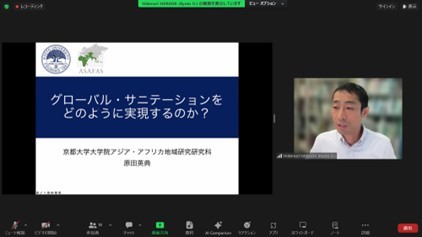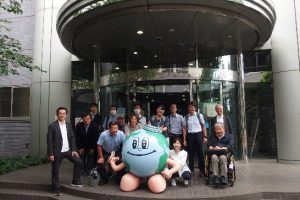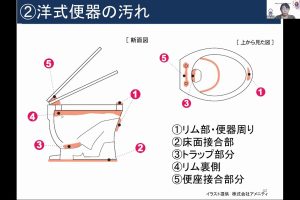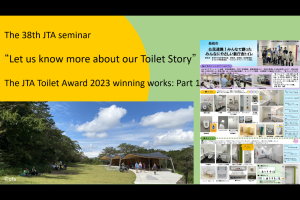Japan Toilet Association (JTA) Seminar Series; “Let us know more about our Toilet Story”
Date: 16 May 2024 (Thu) 18:00-20:00 JST
- Presenter
- Hidenori Harada, Ph.D. (Associate Professor, Graduate School of Asian and African Area Studies, Kyoto University)
“How to realize the global sanitation?”
Lecture Outline
Moderator: Mikiko Takahashi, Ph.D.
Today, we will hold the 35th “Let us know more about our Toilet Story.” The theme is “How to realize the global sanitation.1)” We have invited associate professor Harada, the Graduate School of Asian and African Area Studies of Kyoto University.
Associate professor Harada has been researching the toilets in Africa and Asia, and is working hard to make pervasive and improve the toilets and environment in Zambia and Uganda. Today, he will introduce us to some examples of the rural areas in Zambia and Malawi, and this opportunity we would like to consider about the importance of the toilet sanitation.
1) “The global sanitation” means an effort to improve the sanitation conditions on a global scale so that all people can live in a safe and clean environment. Specifically, this includes ensuring access to the safe drinking water, setting the appropriate toilets, and promoting the hygiene habits.
(Harada)
Today, I would like to introduce the challenges of the global sanitation with my efforts. The current state of the sanitation around the world is many people still cannot access to the safely managed facilities. In particular, in sub-Saharan Africa, three out of four people have no access to the safe services, and one out of five people defecate in the open field. In slums in Nepal and Bangladesh, the water pollution caused by the excrement becomes a serious problem.
The concept of WASH 2) combining the water and the sanitation is important to solve the global sanitation issues.
2) WASH is an abbreviation for WAter, Sanitation and Hygiene. It is a comprehensive term that refers to access to the safe water, use of the appropriate sanitation facilities, and the practice of the hygiene habits.
In terms, “sanitation” and “hygiene” are different, but interrelated. The sanitation is a concept that includes not only the toilets but also the proper treatment and disposal of the excrements by the people.
Inadequate sanitation is one of the main causes of the diarrhea-related deaths, especially children under the age of five. Therefore, the sanitation is positioned as an important issue in Goal 6 of the SDGs. However, the simple funding is not enough to solve this problem. There exist various barriers, such as the difficulty of the developing sewerage systems and the problem of the pit latrines.3)
3) A pit latrine is one type of the toilet that excretes into a hole in the ground. While the pit latrines have the advantage of being inexpensive and easy to build, they also have the problems such as the groundwater contamination, the transmission of the pathogens by the flies and pests and the bad odours.
One reason why the sanitation is given low priority in society as a whole is that it is invisible the direct connection to the health effect. Simply installing toilets cannot bring the visible effects. An important method to achieve this is to “visualize” the value of the sanitation.
I focused on the sanitation as the fertilizer in order to improve the sanitation in rural areas as a material motivation. The farmers accepted the use of the excrement as fertilizer, when we introduced technology to separate the urine and excrement. However, the application of the urine was limited. The background to this was a lack of understanding of the fertilizer value on the urine and concerned about its health effects by them.
Meanwhile, a “Health-based Motivation” approach was attempted in urban slums in Zambia. A Community-Participation survey4) was conducted to visualize the sanitation conditions in the living environment, and it resulted in increased the awareness of the sanitation by the local residents.
4) “Community-Participation Survey” is a method where the local residents actively participate in the survey to understand local issues and needs. Unlike the traditional surveys conducted by only the experts, it involves the local residents in the process of the planning, implementing, and analyzing the survey. Often it can collect more information with the local conditions.
Expanding on this initiative, we are currently working with JICA (Japan International Cooperation Agency) on a community-participatory sanitation improvement project using an App. The trials of the value of the sanitation visible and local people aware of its importance will be able to solve the problem. While doing this, there are variety of approaches that take into account the circumstances or environments of each region. Using the human waste as a resource is effective in rural areas, but this will not be applied in the urban areas. People in developed countries including Japan, will need to be aware of the resource use and treatment of the excrements and consider the issues of the sanitation.
To solve the sanitation issues, it is important to have a global perspective and take action that is tailored to the local situation. Such examples can be the references for the toilet matters in Japan at the catastrophic disasters. The sanitation can be said a matter of the personal dignity as well as a public issue. There is required to raise the public interest and bring together various stakeholders to consider.
Q&A
(Q1: M. Takahashi) How to be recognized in the south Saharan Africa about the toilet situation in the developed countries?
(A1: Harada)
In urban areas of sub-Saharan Africa, the modern toilets are being installed mainly in the wealthy areas. Therefore, the slum residents can recognize of their existence. However, the current situation is that improving toilets is a low priority compared to the increasing numbers of the smartphones. As mentioned earlier, the background to this is that it is difficult to be visible effects just by installing toilets.
(Q2: M. Takahashi) Do you have any data or findings about the effectiveness of the awareness-raising activities to date?
(A2: Harada)
Currently, we are working on a five-year project that includes the quantitative verification in the part of JICA plan. We place importance on gathering objective information and facts to support our claims and hypotheses by verifying the effectiveness of our awareness-raising activities. In addition, we believe it is important to both appeal to the local government officials who have influence over the toilet setting and repair, and to appeal to residents who daily use the toilets especially young people.
(C3: M. Takahashi) We learned the importance of not only “improving” toilets, but also appealing their “value” by your lecture today. The speech was very inspiring and provoking us.
(Q4: KA) As the sewerage systems become more widespread, the fertilizer from the excrement will no longer be used. I am worried that the chemical fertilizers, which use energy, may increase. What would you think about this matter?
(A4: Harada) As you pointed out, I think it’s a waste that the fertilizer components in the excrements are lost by the sewage treatment. In Europe and United States, the agricultural use of the sewage sludge is being reconsidered. In African countries, the rate of the sewerage coverage is low, so I think the technology like separating the urine and excrement is more realistic. Especially in rural areas, the feasibility of using it in agriculture will be high possibility.
(Q5: YA) In the past, I worked on the system with installing the rainwater tanks by using the concrete rings in Khulna, Bangladesh against the arsenic contamination of the well water. At that time, the method of using those concrete rings to build toilets became widespread locally. Do you know the status of the spread of the concrete ring toilets since then?
(A5: Harada) When I visited Bangladesh about 10 years ago, I saw that concrete ring toilets (Cf.). They were becoming more and more popular in various areas. This made me realize the importance of selecting and spreading the technology adapting to the local situation.
Cf. A concrete ring toilet is a simple toilet made by stacking the concrete rings. It is mainly popular in developing countries, and has the advantage of being inexpensive to build.
(Q6: HO) Could you please explain me the definition of the term WASH (Water, Sanitation and Hygiene)? In particular, I would like to know the difference between sanitation and hygiene. In the toilet, is sanitation the primary function and hygiene the secondary function?
(A6: Harada) The WASH concepts of the sanitation and hygiene are often lumped together under Japanese expression. However, in the context of the international cooperation, it is important to distinguish between them. In English-speaking countries, the sanitation refers primarily to the management and treatment process of the excrement. While the hygiene refers to the personal habits. The hygiene refers to keeping toilets clean, but the excrement treatment is part of the sanitation.
(Q7: HO) What is your idea on the role to be expected of us in Japan, including Japan Toilet Association?
(A7: Harada) I would like to convey to all those involved in Japan including JTA, that it is important to consider how to dispose of the excrements with the subsequent impact on the environment. In order to support developing countries, we need to devise ways to create the hygienic toilet environments even in places without the sewerage systems. I think there is high potential for applying the traditional Japanese pit toilets and the simple flush toilets with small amount of the water.
We also need to focus on the detailed issues more, such as for the elderly and disabled people and cares for women of their periods. The academic efforts are also gaining momentum to look at the sanitation from a gender perspective.
There are many issues about the toilet sanitation. It is important to accumulate the wisdom of Japan and solve them one by one for the global solidarity. I hope today’s lecture will be the first step to solve the issues. Appreciated for your participation.










